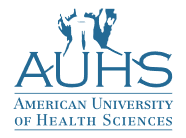 By Oksana Zayachkivska, MD, PhD, DSc, Professor of Physiology, AUHS-SOM
By Oksana Zayachkivska, MD, PhD, DSc, Professor of Physiology, AUHS-SOM
Grant proposal for a new saliva test from AUHS School of Medicine (SOM)
Human readiness for performing important routine and essential tasks is a vital skill. The quality of human performance of neurocognitive processes (memory, attention, thought process) as well as physical condition are related to physiology-based metabolic homeostasis. Saliva is a biofluid that reflects not only the health of the local oral cavity but could also serve as a “mirror” of general health (1). Using biosensors for noninvasive rapid evaluation human health is modern diagnostic approach in preventive medicine and health care. In our previous study in animal models of human esophageal and gastric diseases, we showed that normal salivation provides the necessary amount of numerous bioactive molecules that also exert cytoprotection of the esophagogastric mucosa (2). Our previous study was also related to the study of saliva microcrystallization in humans as an easy-to-do, non-invasive and inexpensive method for the detection of changes in homeostasis mostly of its neuro-hormonal control (2).
Saliva microcrystallization is the part process of biopolymerization – the formation of solid crystals precipitating from biofluids in which from a liquid solution to a pure solid crystalline phase occurs. Taking in account that nature of the crystallization process refers to both thermodynamic and kinetic factors (motion of the molecules and the forces and energy acting on them), which can reflect current “real-time” condition of personal metabolic homeostasis and performance activities. It highly variable and under control of many physiology-based factors, including:
- human condition,
- activities,
- age,
- sex,
- circadian influences.
Our hypothesis was to shown that detection types of saliva microcrystallization can be used as an additional method of estimation of integrated view on human health condition and individual stress resilience. Our obtained results using saliva were based on the detection of changes in the pattern of microcrystallization, after dehydration of saliva drops. We detected different morphological types of saliva microcrystallization using microscopic and macro-magnification photo recording by existing cell phone technology. They were strong visual changes in the appearance of saliva microcrystallization under different human activities and stress conditions (3, 4).
 Recently, 15th of September, 2022, faculty of AUHS-SOM, in consultation and collaboration with a nearby bioengineering firm Second Order Effects Engineering Consultants in El Segundo, CA, submitted proposal for Defense Advanced Research Projects Agency (DARPA), the central research and development organization for the US Department of Defense, for project “Smart Non-invasive Assays of Physiology (SNAP)” aimed to develop a portable device that can predict warfighter readiness through sensing and assessment of molecular biomarkers from an individual’s bodily fluids.
Recently, 15th of September, 2022, faculty of AUHS-SOM, in consultation and collaboration with a nearby bioengineering firm Second Order Effects Engineering Consultants in El Segundo, CA, submitted proposal for Defense Advanced Research Projects Agency (DARPA), the central research and development organization for the US Department of Defense, for project “Smart Non-invasive Assays of Physiology (SNAP)” aimed to develop a portable device that can predict warfighter readiness through sensing and assessment of molecular biomarkers from an individual’s bodily fluids.
We will introduce a health-related mobile application (m-Health) with biosensors that can offer a unique opportunity to detect & correct impairment in tasks by creating a rapid diagnostic multimodal method for assessment of readiness. Our goal is to create a multidimensional biosensor-based HARST – Health And Readiness Saliva Test for early detection of changes in readiness that will help optimize soldiers’ physiology-based health, and prevent mental & physical health deteriorations.
The HARST will be multidimensional, based on multi-omics technology, relying on the smartphone, after development by a multidisciplinary team of experts both from academia and private industry (fig.1).
References
- Zayachkivska OS ed. Physiology of digestive system / Handbook for students of the medical faculty. // Bezpalko L.Yu., Savytska M.Ya., Kupynyak N.I. – Danylo Halytsky Lviv National Medical University, 2018. – 88 р.
- Zayachkivska O.S. (2006) The role of salivary endogenic bioregulators in the formation esophagoprotection at experimental injury of the esophagus. Contemporary Gastroenterology, 30 (4):65-71.
- Belyak A, Zayachkivska O (2017) How to analyze test of saliva microcrystalisation as a predictor of stress resistibility and an approximate ovulation time? Medical Sciences 2(L):106-109.
- Zvir, M., Beliak, A., Pohoretska, Y., Savytska, M., & Zayachkivska, O. (2017). The Relationship of Saliva Microcrystalline Characterization and Contractile Duration of Skeletal Muscle in Medical Students. Southeastern European Medical Journal: SEEMEDJ, 1(1), 59-66.

